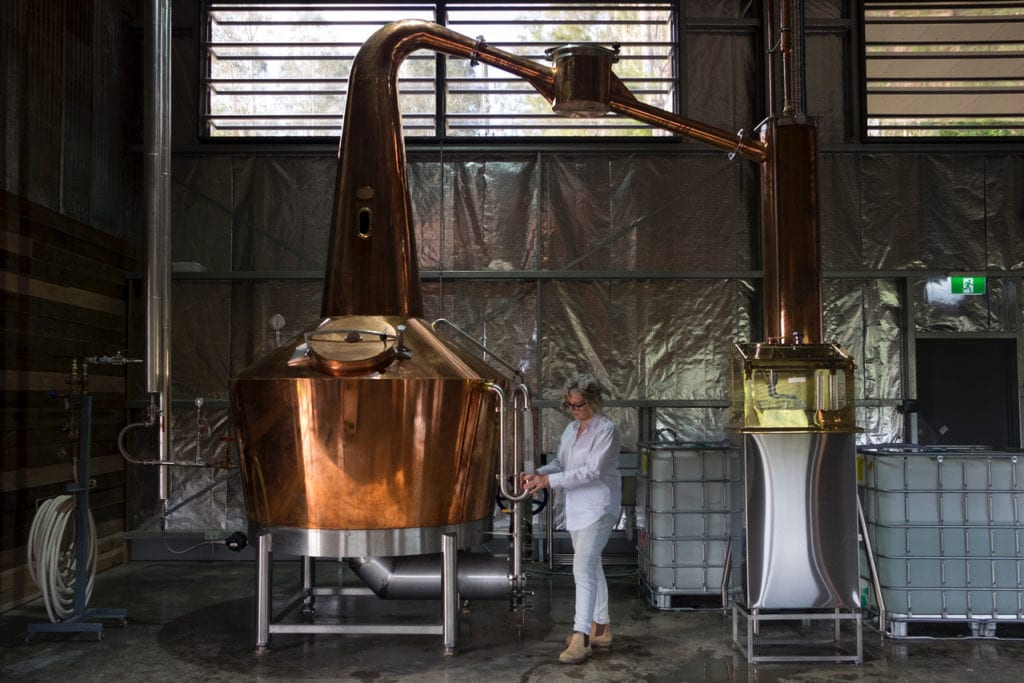This is all changing.
In recent years–especially in Australia– women have been making their mark on liquor industries and proving what passion, determination and a love of the land can lead to. And they’re particularly capitalising on the nation’s love affair with gin.
Take Pam Brook, from Byron Bay’s Cape Byron Distillery. In 1989, she and her husband Martin bought 96 acres of rundown dairy farm and planted it out with 4000 macadamia trees and 35,000 rainforest trees.
At first their ambition was to restore the Big Scrub rainforest which had been lost in the 1800’s, but through that pursuit they learnt of all the incredible botanicals, fruits and spices that grew in the dense forest and decided to start a family gin business.
“Everything we do features native produce from our farm, our rainforest and our region,” she shares with me.

Cape Byron Distillery opens its doors daily to the public, with the brand’s ethos very much centred around sustaining the natural environment that envelops them and their product. “A walk through our rainforest tells the story of our deep connection with the land and our lightest touch footprint on the environment around us,” says Pam.
While Pam started off distilling, her role is now heavily bedded in research and development. She spends her days looking into new botanicals, sourcing native ingredients from other farms in the region, and encouraging other farmers to grow more native bush foods.
“Being connected with our community and industry in our region is always fundamental to us. Being a zero waste and zero emissions farm and facility is our short term goal and we are nearly there.”
A similar approach is taken by Applewood Distillery in South Australia, where chief distiller Laura Carter says their gin “has 20 different botanicals including locally roasted wattleseed, desert limes from WA and peppermint gum from SA.”
Like Pam, Laura and the team at Applewood foster a deep connection with the land and a forefront belief that sustainability is key.
“We source the majority of our produce directly from farms and want our distillery to exist as part of the agricultural community by supporting sustainable agriculture and paying fair prices for second grade produce,” she shares.
Like the Brook’s, the team at Applewood have their sights on purchasing a farm in the near future and growing produce for their creations there.
“‘I’d love to start working on how to get the botanicals we use in our gin to become staples in kitchens and gardens in Australia,” says Laura.

Applewood has also recently started exporting its gin to the United States, with Laura travelling there and elsewhere throughout the year to talk about the business, Australian botanicals and farms. She describes this as an “exciting” and energising part of her role.
And, with Aussie gin making its way to foreign lands, it’s perhaps no surprise that other gins are making their way here too.
Tina Warner grew up on a farm in North County Dublin. She started her career in private equity, so was no stranger to male dominated professions.
When she and her husband Tom decided to open their own gin distillery in the UK’s Northampton, they had no drinks industry experience but “began with a farm and the initiative and determination” to create something with “impact” that would result in a legacy.
The couple landed on gin because “the market was starting to look promising.”
“With the farm we also had a great water source and hedgerow botanicals so we knew we could potentially create something quite special,” Tina explains.

Now almost 7 years into their mission, Tina and Tom have taken their humble brand ‘Warner’s’ to the next level. They’ve become leaders in the craft gin category with their Rhubarb Gin, currently the UK’s number one super premium flavoured gin.
Warner’s has also recently expanded to Australia with Tina and Tom recognising a colossal opportunity.
To say gin’s popularity had grown locally would be an understatement. Statistics from the 2018 International Wine and Spirit Report showed Australia’s gin consumption grew by almost 33 per cent from 2017 to 2018 and more than 15 per cent from 2013 to 2018.
Warner’s is already a multi-million business, but with roots in a new (and thirsty) Aussie market, it will likely skyrocket. The same opportunity exists for local distillers like Applewood and Cape Byron.
Of course with every opportunity, challenges exist. To be successful in a rapidly expanding and highly competitive market, proactive steps must be taken.
“Talk to people in the industry first. Get the right training – you need to love and respect spirits for their taste and flavour and their history,” says Pam Brook.
“Be prepared to learn from the ground up and leave egos at the door. What you give to the team you’ll get back in spades. Live the passion of the business,” she advises anyone looking to enter gin distilling.
It’s a sentiment that Tina Warner shares. She advises prospective distillers to “make sure there is a market for your idea or product and that you’ve got clear differentiation that you can own authentically.”
“Take the first step, (that’s the hardest) and don’t be afraid to reach out to people, ask questions, call in favours and look for advice.”
“Keep going, it’s bloody hard and don’t be afraid to fail. That’s really what gets to success. If you’re not failing fast often, and learning from it, you’re not going to get to what good looks like.”
The best gin recipes for Christmas?
Tina’s pick: ‘A refreshing thirst-quencher’
Take your favourite large wine glass from the cupboard, fill with ice and add a double measure of our gorgeous Warner’s Rhubarb Gin. Top with tonic and add a big slice of orange to finish – delicious!
Pam’s pick: ‘A Partridge in a Pear Tree’
Garnish: Dehydrated pear & Baby’s-Breath.
Ingredients:
- 45ml Mac.by Brookie’s
- 30ml Vodka
- 30ml Pear Purée
- 15ml Lemon Juice
- 15ml Honey Syrup
Method: Shake with ice & double strain into glass.
Laura’s pick: ‘Keep it simple’
Gin and Tonic is always my go-to drink when it’s warm. Lots of crushed ice and lemon thyme garnish. You won’t be disappointed!


